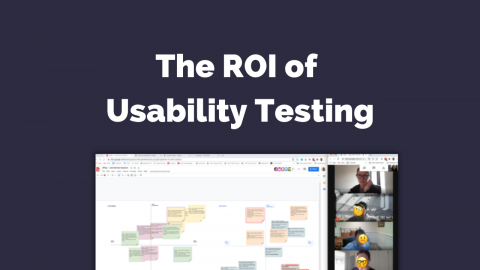The ROI Of Usability Testing
Usability testing is the final type of user research to consider in our effort to help you identify the potential of an ROI for user research. This occurs when the product or website is close to complete but not yet launched, and the purpose is to identify ways the experience can be refined.
This post is part of a series on calculating the ROI of user research!
Start with part one, the ROI of discovery research. Then, check out the ROI of concept validation.
The Investment for Usability Testing:
In order to conduct Usability Testing, you’ll need to have a coded version of your solution on (at least) a staging environment. It does not have to be completely finished and ready to be pushed to production but should be most of the way there. A set of tasks will need to be constructed that will be given to testing participants to complete (with little to no context or help).
If possible, conduct Usability Tests in a realistic user setting so that realistic reactions to distractions and/or steps in the journey that take place outside of your solution can be observed. This ensures that the solution will work in the right context and environment, post-launch.
The Return on Usability Testing:
Insights on how to make your solution more intuitive are the key recompense for Usability Testing. At this point, the core project team has been working closely with the product for months and it takes someone who isn’t familiar with the solution to properly test drive it. If Concept Validation research took place, the insights from Usability Testing should be much smaller and easier to implement. It can also begin to inform what the v2.0 roadmap might need to include.
When To Invest in Usability Testing:
The biggest factor when deciding to include Usability Testing is the size of the launch plan. If the audience, brand, and budget of the launch are going to be considerable, it is wise to take this extra step to de-risk that launch. Usability Testing can also be helpful when testing new interaction models or when the solution is for a target user segment with lower than average technical skills.
When Not To Invest in Usability Testing:
If the product or website is going to have a soft launch as opposed to a big splash, it may not be necessary to invest the effort in usability testing. However, it is important to have an agile team on standby to react to the needs of users in the soft launch. Likewise, if the solution design is free of complexities (basic functionality only) and using best practices (not attempting to forge any new design interactions), there will be less to gain from a formal Usability Test.
The Consequences of Foregoing User Research
The last option to explore is doing no user research at all. This is usually not an intentional decision made at the forefront of a project but can be a byproduct of shifting project scope and timelines.
The Investment:
None.
The Return:
Moving faster. Not having to use budget, timeline, and resources for the task of User Testing. But is it really worth the risk?
With speed to market, you also increase risk. The risk lies in not reaching desired goals after your product team has spent a great deal of time and effort to bring the product to market. And this can be a very costly mistake.
We’ve seen projects that started with well-polished pitch decks including strong, third-party market research but the product team never took the time to talk to potential users. As a result, the solution missed key assumptions and fell (sometimes radically) short of the expected KPIs. In the grand scope of scenarios like this, I’m sure the product teams would sacrifice a week here or there to get input throughout the product development process.
When Not To Conduct User Research:
Projects with zero to little risk can afford to forgo all user research. This would include brochure websites and basic blogs.
When To Conduct User Research:
Most of the time you’ll want to consider at least one form of user research. It helps product teams look at their solutions from many different angles and ultimately makes them stronger because they learn how to adapt.
Tips to Reduce the Costs of User Research
User research might not need to be conducted at every interval of every project but, there is certainly value in taking the time to pause at least once to collect user feedback. The key is understanding which type of user research will return the most value to your project.
Here are a few more tips to reduce the cost of conducting user research.
- Use third-party recruiting services like usertesting.com can be very efficient when there is not a readily-available pool of test participants.
- Reduce the volume of back-and-forth emails by employing automated scheduling tools like calendly.
- Reduce the time it takes to analyze results by implementing two-person research teams when conducting interviews. This ensures there is a dedicated team member for live note-taking.
- Reduce overhead on presentations and keep user research learnings informal but still referenceable. It’s more important that testing results live on through updates to the solution, not in a fancy slide deck. One well-organized spreadsheet per test can be a good-enough reference tool.
For more on user research and all things related to creating and developing successful applications that prioritize the end-user, be sure to follow the ADK blog!
Learn more on how ADK applies the rules of User Research.
